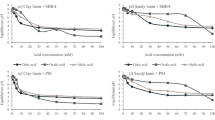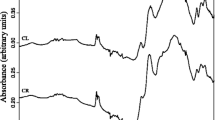Abstract
The effectiveness of large single applications of North Carolina reactive rock phosphate, Queensland non-reactive rock phosphate, and Calciphos, were compared to the effectiveness of superphosphate in field experiments in south-western Australia for up to 11 years after application. As measured using plant yield, superphosphate was the most effective fertilizer in the year of application, and relative to freshly-applied superphosphate, the effectiveness of the superphosphate residues declined to be about 15 to 65% as effective in the year after application, and 5 to 20% as effective 9 to 10 years after application. Relative to freshly-applied superphosphate, all the rock phosphates were 10 to 30% as effective in the year of application, and the residues remained 2 to 20% as effective in the 10 years after application. The bicarbonate soil test reagent predicted a more gradual decrease in effectiveness of superphosphate of up to 70% 10 years after application. For rock phosphate, the reagent predicted effectiveness to be always lower than for superphosphate, being initially 2 to 11% as effective in the year after application, and from 10% to equally as effective 10 years later. Therefore rock phosphates are unlikely to be economic alternatives to superphosphate in the short or long term on most lateritic soils in south-western Australia.
Similar content being viewed by others
References
Barrow NJ and Bolland MDA (1990) A comparison of methods of measuring the effect of level of application on the relative effectiveness of two fertilizers. Fert Res 26: 1–10
Barrow NJ and Campbell NA (1972) Methods of measuring residual value of fertilizers. Aust J Exp Agric Anim Husb 12: 502–510
Bolland MDA (1985) Residual value for wheat of phosphorus from Calciphos, Duchess rock phosphate and triple superphosphate on a lateritic soil in south-western Australia. Aust J Exp Agric 25: 198–208
Bolland MDA (1994) Effectiveness of two partially acidulated rock phosphates, coastal superphosphate and Ecophos, compared with North Carolina reactive rock phosphate and superphosphate. Fert Res 38: 29–45
Bolland MDA and Barrow NJ (1988) Effect of level of application on the relative effectiveness of rock phosphate. Fert Res 15: 181–192
Bolland MDA, Bowden JW, D'Antuono MF and Gilkes RJ (1984) The current and residual value of superphosphate, Christmas Island C-grade ore, and Calciphos as fertilizers for a subterranean clover pasture. Fert Res 5: 335–354
Bolland MDA and Gilkes RJ (1989) Reactive rock phosphate fertilizers and soil testing for phosphorus: the effect of particle size of the rock phosphate. Fert Res 21: 75–93
Bolland MDA and Gilkes RJ (1990) Rock phosphates are not effective fertilizers in Western Australian soils: a review of one hundred years of research. Fert Res 22: 79–95
Bolland MDA, Gilkes RJ and Allen DG (1988a) The residual value of superphosphate and rock phosphates for lateritic soils and its evaluation using three soil phosphate tests. Fert Res 15: 253–280
Bolland MDA, Weatherley AJ, Gilkes RJ and Bowden JW (1986) Granular reactive apatite rock phosphate is not an effective phosphorus fertilizer in the short term on lateritic soils in south-western Australia. Aust J Exp Agric 26: 217–225
Bolland MDA, Weatherley AJ and Gilkes RJ (1988b) Residual effectiveness of superphosphate is greater than that of rock phosphate fertilizers for lateritic soils in south-western Australia. Aust J Exp Agric 28: 83–90
Bolland MDA, Weatherley AJ and Gilkes RJ (1989) The long-term residual value of rock phosphate and superphosphate fertilizers for various plant species under field conditions. Fert Res 20: 89–100
Chien SH and Hammond LL (1978) A comparison of various laboratory methods for predicting the agronomic potential of phosphate rocks for direct application. Soil Sci Soc Am J 42: 935–993
Colwell JD (1963) The estimation of the phosphorus fertilizer requirement of wheat in southern New South Wales by soil analysis. Aust J Exp Agric Anim Husb 3: 190–197
Earle DF and McGowan AA (1979) Evaluation and calibration of an automated rising plate meter for estimating dry matter yield of pasture. Aust J Exp Agric Anim Husb 19: 337–343
Engelstead OP, Jugsujinda A and De Datta SK (1974) Response by flooded rice to phosphate rocks varying in citrate solubility. Soil Sci Soc Am Proc 38: 524–529
Fenster WE and Leon LA (1978) Utilisation of phosphate rock in tropical soils in Latin America. Seminar on Phosphate Rock for Direction Application, Haifa, Israel, pp 174–210. (Muscle Shoals, Alabama: Special Publications IFDC-SI)
Hammond LL (1978) Agronomic measurements of phosphate rock effectiveness. Seminar on Phosphate Rock for Direct Application, Haifa, Israel, pp 147–173. (Muscle Shoals, Alabama: Special Publications IFDC-SI)
Hughes JC, and Gilkes RJ (1994) Rock phosphate dissolution and bicarbonate-soluble P in some soils from south-Western Australia. Aust J Soil Res 32: 767–797
Khasawneh FE and Doll EC (1978) The use of phosphate rock for direct application to soils. Ad Agron 30: 159–206
Kumar Vijay, Gilkes RJ and Bolland MDA (1993) Forms of phosphate in soils fertilized with rock phosphate and superphosphate as measured by chemical fractionation. Aust J Soil Res 31: 465–480
Kumar Vijay, Gilkes RJ, Armitage TM and Bolland MDA (1994) Identification of residual P compounds in fertilized soils using density fractionation, X-ray diffraction, scanning and transmission electron microscopy. Fert Res 37: 133–149
Author information
Authors and Affiliations
Rights and permissions
About this article
Cite this article
Bolland, M.D.A., Gilkes, R.J. Long-term residual value of North Carolina and Queensland rock phosphates compared with triple superphosphate. Fertilizer Research 41, 151–158 (1995). https://doi.org/10.1007/BF00750757
Received:
Accepted:
Issue Date:
DOI: https://doi.org/10.1007/BF00750757




